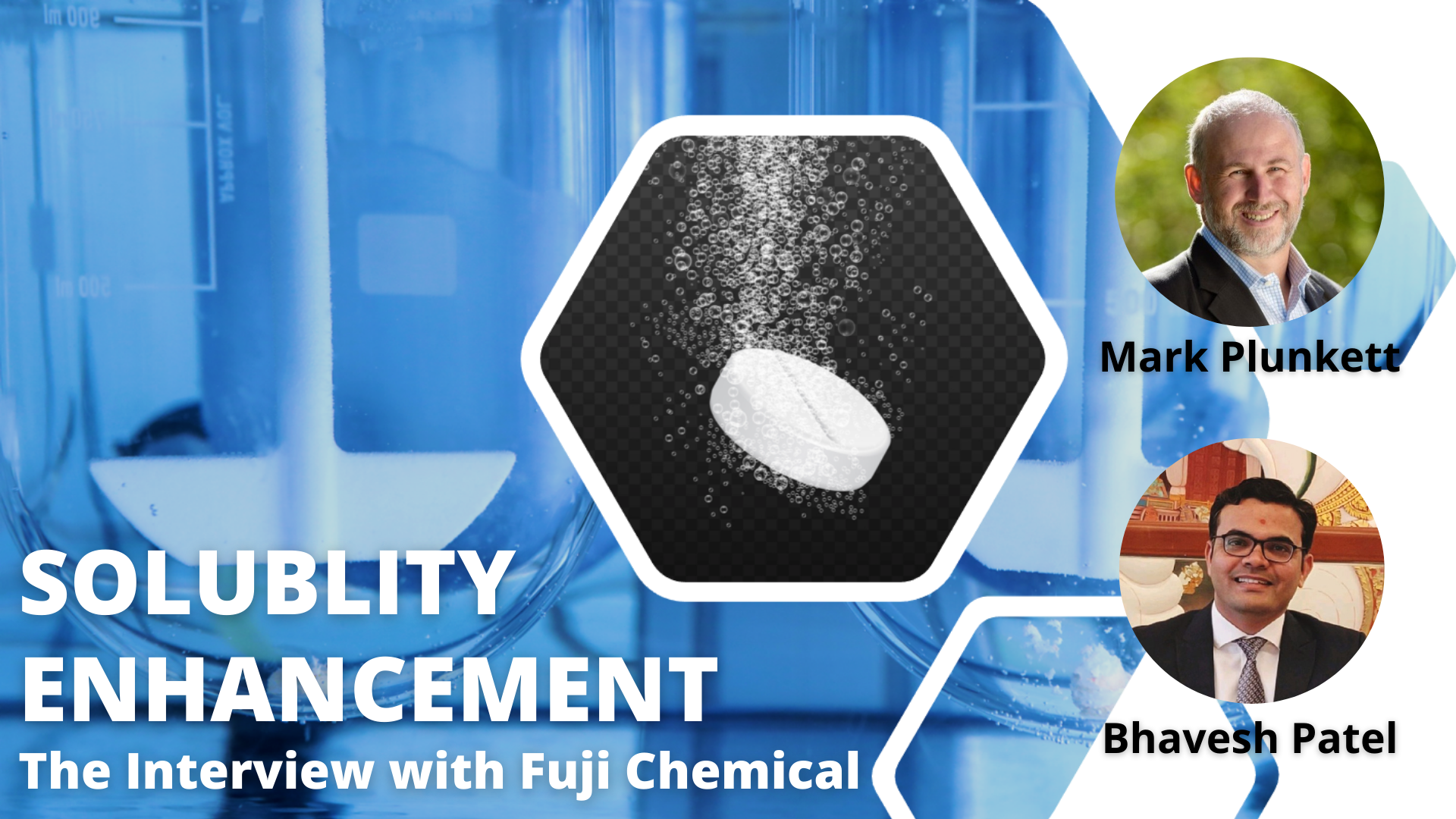Solubility enhancement – The Interview with Fuji Chemical

Fuji Chemical Industries specializes in producing porous spray-dried excipients for the pharmaceutical and nutraceutical markets. They spray-dry their excipients to produce free-flowing granules and unique internal structures that enhance compressibility and functionality. These structures are ideal to solve your solubility issues when it comes to dealing poorly soluble API’s. Find all Fuji excipients here!
We took the chance and made an interview with the responsible product managers from Fuji about the best excipients for solubility enhancement! Read the full transcript here.
See the full video interview here:
Download the technical datasheet about Neusilin® for solubility enhancement here
or the complete Fuji excipients brochure here!
Fuji has a large portfolio of products specifically designed for solving your solubility enhancement issues. For help in choosing the correct product, please feel free to contact us or read over Fuji’s brochures. However a good starting point is always the use of Neusilin® US2 for pharmaceutical applications and Fujicalin® for nutraceutical and food applications.
Interested in a sample or more information? Click here!
Transcript:
Pharma Excipients: Good morning, Pharma Excipients community, today we have our two guests from Fuji Chemical again. Mark Plunkett, technical director and Bhavesh Patel, Technical Service Manager. Our topic today is solubility enhancement in Solid oral dosage forms. So if you’re looking for a solution to solubilize your oral solid dosage form, watch this interview. And as always, do not hesitate to contact us if you have more questions or need a sample. Bhavesh, Mark, thank you for being here with me again. Now, let us directly start with my first question. I understand Fuji Chemicals has some great solutions for solubility enhancement in solid oral dosage forms. Why is solubility such an important issue in pharmaceuticals?
00:00:55
Mark: Well, Tom, with oral solid dosage forms, we obviously swallow a drug. And for it to have an effect on the body, it has to actually get to the site of action. The first step in this process is to be in a soluble form. We then transverse the GI tract and safely diffuse to the relevant site. This is why issues such as permeability and first pass through the liver are also of importance. So solubility is clearly the first of these critical steps in order to achieve bioavailability and thus the activity of drug products.
00:01:26
Pharma Excipients: Is this issue common?
00:01:29
Bhavesh: Yes, Tom. It is a common issue. As you are aware that, the most drugs have common solubility issues. In particular, around 40 to 70 percent of new chemical entities has issues with the poor solubility. And thus, the poor solubility will become a larger issue over a period of time
00:01:48
Pharma Excipients: I’ve heard people refer to the biopharmaceutical classification system BCS when discussing solubility. What is it again?
00:01:57
Bhavesh: Yes, biopharmaceuticals classification system deals with both solubility and permeability. It is very simple as higher and lower for each because it is a kind of matrix system, and it gives a correlation between the four different areas. As Mark has already indicated that both solubility and permeability go hand to hand. For example, class 2 drug has good permeability but poor solubility. Whereas class 4 drug has poor solubility and permeability. Therefore, Fuji’s solution allows you to address both. And we really focus on solubility from class two and class four.
00:02:35
Pharma Excipients: OK. And how is solubility and normally addressed?
00:02:39
Mark: Traditional approaches to solve poor solubility were to increase the surface area things like grinding up to create a high surface area. And that leads to a faster dissolution rate or approaches, such as changing the form to something that’s more soluble and hence the prevalence of such approaches as co-crystals, salts prodrugs and the use of the amorphous face.
00:03:04
Pharma Excipients: Can you explain the approach Fuji uses to solve solubility enhancement?
 Download the full Fuji excipients brochure here
Download the full Fuji excipients brochure here
00:03:09
Bhavesh: Yes. Sure. The ultimate aim is to achieve a high surface area of amorphous material. Internal high porosity of the Fuji excipient is perfect scaffolding confinement for the creation of a high surface area amorphous phase by effect of surface chemistry. And that can be created by achievement of the surface chemistry. But in order to take a larger crystal and put them into a highly porous material with a very small, tiny pores, we need to unsettle the crystal and reform the amorphous phase. And this requires that we are going through a liquid stage. The way this can be achieved is typically either to use a solvent by dissolving a drug into some common solvent or by melting approach to melt the product into the pores. And most of such process can be done with different technologies such as spray drying and hot-melt extrusion.
00:04:03
Pharma Excipients: Can you give an example for that?
00:04:07
Mark: OK. As Bhavesh mentioned, these large crystals need to go into a small pores in our porous carriers. And one of the easiest way to do this is to dissolve it in a solvent. So one of the typical examples I would use is the class 2 BCS drug fenofibrate. There’s a nice publication on it and hence a nice use that people can ask for which publications we can put that in in below. So in this case, we use the methanol as a solvent for the for the active and then we just like we would with an oily material. We can just get that liquid and it’ll be pulled into the pores from capillary forces. Once it’s inside the pores, we then just need to dry the system, so maybe use a vacuum and and the methanol can come off, which was used in this publication. So when that occurs, due to the confinement effects and the effects of surface chemistry, instead of forming a crystalline phase, we form the amorphous phase. And because it coates these very high surface areas, we get the combination of the high surface area and the more soluble, amorphous phase, and that’s what we’re really after. So in this paper, that’s what they got. We had a nice, stable bioavailable increase in solubility and the approach of doing this, which was in a fluidized bed, resulted using fairly standardized equipment leads to homogeneous loading. And there’s no heating of the API, so we can use that with temperature sensitive APIs.
00:05:42
Pharma Excipients: Can you give an example where solvents aren’t required? I think about the hot-melt extrusion method.
00:05:48
Bhavesh: Yes, the melting approach is quite simple, and we just need to convert a crystalline drug into a low viscosity, molten phase so it can easily enter into the pores. We can do such things by heating the drug above the melting temperature. This can be done in different ways and what are the most elegant approach is to use hot-melt extrusion forces. The advantage of this approach is that we don’t require the solvent. So, it’s completely solvent free process. Hot-melt extrusion is typically used with the polymer, hydrophilic polymer. But of course, in this case, we are talking about the use of inorganic porous excipients like Neusilin. So, let me highlight some of the advantages for using inorganic porous excipient in hot-melt extrusion. One of the advantages here, the down streaming part is not required with inorganic porous excipient. especially like cooling and cutting/milling of extrudes. Second element is that usually, cleaning is a higher time-consuming process. So, we can significantly reduce the cleaning time compared to the hydrophilic polymer and increase the production output. And the most important element is that inorganic porous excipient has moisture adsorption properties. So, the stability of amorphous state of API can be improved by minimizing drug conversion from amorphous to crystalline stage during storage.
00:07:13
Pharma Excipients: You just didn’t refer to spray drying. I thought this was a key area for Fuji and one that could be used for solubility enhancement.
00:07:22
Bhavesh: Yes, it is Tom. A spray drying is another amorphous solid dispersion approach for the solubility enhancement. This, however, requires a relatively specialized equipment. And if people are interested and if they don’t have that capability for the commercial scale spray drying, then they can approach to Fuji. And we are offering the contract manufacturing business for solubility enhancement via spray drying process.
00:07:48
Pharma Excipients: So we covered a lot of ground here. Can you briefly summarize and discuss the benefits of the Fuji approach?
00:07:55
Mark: Sure. So we’re talking about oral solid dosage forms and the need for drugs to become bioavailable. And this requires the solubility for crystalline drugs. And if this poor solubility we need solutions, the approach that we’re talking about is a combination of high surface area on one hand and a more soluble, amorphous face on the other. This is achieved by solidifying our drug from some sort of liquid into a porous carrier and coating the very high surface area of that carrier. The drug confinement and the proximity to the substrate results in a stable, high surface area, amorphous phase and hence an increase in improvement to our bioavailability. Fuji excipients are ideal. Why are they ideal? Because they have a high porosity, allowing us to put more drug into the system. They have the correct pore size distribution, and that’s both in terms of loading and unloading and in the stability of that amorphous phase and the high surface area of that amorphous phase. And one of the things that actually I didn’t mention earlier is that Fuji has a number of different surface chemistries that can be used. So different excipients, and those different chemistries can lead to improvements in the chemical stability, the loading and the release. And finally, the benefits of Fuji as an excipient itself allows for improvements in persisability, manufacturability and finally, tabletability. So as you see, we cover all aspects to use this approach to improve your solubility of your drugs. Thank you.
00:09:47
Pharma Excipients: Thanks a lot for the answer, Mark! Thanks for this great interview, both of you two. I learned a lot solutions for solubility enhancement today and I hope our users, too. Bhavesh, Mark, thanks again very much for your time.
00:10:02
Mark: Thanks, Tom. That’s appreciated.
00:10:04
Bhavesh: Thank you. Thank you very much.
00:10:06
Pharma Excipients: You’re welcome. Have a good day, both of you, and I hope we see us again. Bye bye.
 Download the full Fuji excipients brochure here
Download the full Fuji excipients brochure here

